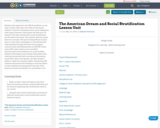
This brief video shows the relationship and movement of particles inside an atom.
- Subject:
- Physical Science
- Material Type:
- Lecture
- Provider:
- NOVA Science
- Provider Set:
- NOVA ScienceNOW
- Date Added:
- 07/15/2013

This brief video shows the relationship and movement of particles inside an atom.

In which John Green teaches you about the life and death of one of history's great explorers, Captain James Cook of the British Navy. He charted large swaths of the Pacific ocean, laid claim to Australia and New Zealand, and died a bizarre death in the Sandwich Islands, which are now called the Hawaiian Islands. Exactly how and why Captain Cook was killed in Hawaii is a long-running historical debate. John presents two interpretations of the event and talks about what the differing interpretations say about history. It turns out how the story is told depends on who is doing the storytelling, and people from different backgrounds can interpret events in very different ways. Also, there is a celebration and a mustache involved in this episode, so you definitely don't want to miss it.
Chapters:
Introduction
Captain James Cook
An Open Letter to "The White Man's Burden"
Captain Cook's Controversial Death
Interpretations of Captain Cook's Death: Makahiki
Issues with the Ritual Death Story
How Cook Actually (Probably) Died
Why Did Cook's Ritual Death Myth Persist?
Credits

In which John Green teaches you about American involvement in World War I, which at the time was called the Great War. They didn't know there was going to be a second one, though they probably should have guessed, 'cause this one didn't wrap up very neatly. So, the United States stayed out of World War I at first, because Americans were in an isolationist mood in the early 20th century. That didn't last though, as the affronts piled up and drew the US into the war. Spoiler alert: the Lusitania was sunk two years before we joined the war, so that wasn't the sole cause for our jumping in. It was part of it though, as was the Zimmerman telegram, unrestricted submarine warfare, and our affinity for the Brits. You'll learn the war's effects on the home front, some of Woodrow Wilson's XIV Points, and just how the war ended up expanding the power of the government in Americans' lives.
Chapters:
Introduction
American Involvement in WWI
The Sinking of the Lusitania
Why did the U.S. join WWI?
Mystery Document
America's Contributions to WWI
Pro-War Progressives
How WWI Expanded the U.S. Government's Power
Propaganda, Public Opinion, and the CPI
The Espionage Act of 1917
The Sedition Act
"Americanization"
Suppression of Free Speech
Positive Outcomes of WWI
The End of WWI
Credits

Students who migrated to the USA from Mexico or any other country when they were kids are the learner audience. However, this lesson series can be adapted for other types of learners. Each lesson will take up to 30 minutes. The topic of lesson #1 is social stratification and the American dream. The students will learn about these two concepts. The goals of lesson #2 are to learn how to create charts and graphs in a PowerPoint after collecting data through interviews and compare/ contrast results with National Survey 2005 NY Times. Lesson #3’s topic is about race as ascribed characteristics and its influence on social mobility. Students will integrate and evaluate information they collected and present their own ideas in discussions. Lesson #4’s topic is how gender can affect people’s ability to climb the economic ladder. During lesson #5 students will present their findings in class and reflect on their experience learning about the topic of the American dream and whether it is achievable or not.

We don’t want to deluge you with information on the subject, but this week on Crash Course Mythology, Mike Rugnetta is talking once again about floods. We’re looking at ancient flood myths in the Americas, and what they can tell us about the stories that people tell, and how they can look similar, even in cultures separated by large swathes of time and space. We’ll talk about floods from Mayan and Aztec traditions, and as always, see if we can find something in these tales that gives us some insight into what it means to be a human.

The United States was founded on the principles of natural rights, equality, and classical republicanism, but how well did it actually live up to these ideals? In this lecture, Professor Rob McDonald of the US Military Academy at West Point describes the conflict between the ideals of the American Revolution and the unfortunate realities of the time.

This is a powerpoint for chapter one of the text.
Faculty using this text can use it as a jumping off place to create their own slideshows for the class.

This is a powerpoint with an outline of chapter 3 of the text.

These PowerPoint slides can be paired with the American Government 3e textbook by Openstax for in-class sections of the course. They provide matierial from the textbook, as well as data from the most recent elections, public opinion polls, and pew research center publications from within the last few years. This material provides both the political history of our country, as well as some pertinent information from current events affecting our political landscape.

These Video Lectures (all of which are accompanied by Supplemental Notes that appear in PDF files) draw upon select aspects of every chapter of the third edition of OpenStax's American Government text. The lectures and notes elaborate upon certain ponts raised in each chapter of American Government by providing additional historical context and relating the textual material to contemporary political events. At various points during the video lectures, quiz questions are asked in an attempt to enhance student engagement. (Quiz questions also appear at the end of the Supplemental Notes to each lecture.) For those who wish to use the quizzes, answer keys are included for each one.

The videos covered in this playlist are from the American Government and Civic Engagement from the American Government 3rd edition textbook published by Open Stax https://openstax.org/details/books/american-government-3e
The videos cover chapters 1 - 14.

In which John Green teaches you about Imperialism. In the late 19th century, the great powers of Europe were running around the world obtaining colonial possessions, especially in Africa and Asia. The United States, which as a young country was especially susceptible to peer pressure, followed along and snapped up some colonies of its own. The US saw that Spain's hold on its empire was weak, and like some kind of expansionist predator, it jumped into the Cuban War for Independence and turned it into the Spanish-Cuban-Phillipino-American War, which usually just gets called the Spanish-American War. John will tell you how America turned this war into colonial possessions like Puerto Rico, The Philippines, and almost even got to keep Cuba. The US was busy in the Pacific as well, wresting control of Hawaii from the Hawaiians. All this and more in a globe-trotting, oppressing episode of Crash Course US History.
Chapters:
Introduction
New Imperialism
Economic Motivations for American Imperialism
The Panama Canal
Rising Nationalism: The Pledge of Allegiance & Flag Day
American Territorial Expansion
Imperialism in the Pacific
The Spanish-American-Cuban-Filipino War
Mystery Document
America Declares War
The Events of the Spanish-American-Cuban-Filipino War
American Territories Gained in the War
American Troops in China & The Philippines
The Philippine War
Puerto Rico, The Philippines, & The Foraker Act
Hawaiian Statehood
Anti-Imperialism
Supporters of Imperialism
Credits

This module on Colonial Literature explore the essential questions: 1) How does the literature in early Colonial America reflect the customs and beliefs of the Native Americans and Puritans? 2)What kind of literary styles did the earliest writers contribute to American Literature? and 3) How did history have an effect on the types of literature being written? There are audio and visual activities as well as readings.

In "The American Novel Since 1945" students will study a wide range of works from 1945 to the present. The course traces the formal and thematic developments of the novel in this period, focusing on the relationship between writers and readers, the conditions of publishing, innovations in the novel's form, fiction's engagement with history, and the changing place of literature in American culture. The reading list includes works by Richard Wright, Flannery O'Connor, Vladimir Nabokov, Jack Kerouac, J. D. Salinger, Thomas Pynchon, John Barth, Maxine Hong Kingston, Toni Morrison, Marilynne Robinson, Cormac McCarthy, Philip Roth and Edward P. Jones. The course concludes with a contemporary novel chosen by the students in the class.

The American Revolution entailed some remarkable transformations -- converting British colonists into American revolutionaries, and a cluster of colonies into a confederation of states with a common cause -- but it was far more complex and enduring then the fighting of a war. As John Adams put it, "The Revolution was in the Minds of the people . . . before a drop of blood was drawn at Lexington" -- and it continued long past America's victory at Yorktown. This course will examine the Revolution from this broad perspective, tracing the participants' shifting sense of themselves as British subjects, colonial settlers, revolutionaries, and Americans.

When we talk about the American Revolution and Revolutionary War, the discussion often involves lofty ideals like liberty, freedom, and justice. The Declaration of Independence even opens with the idea that "all men are created equal." But it turns out, the war wasn't being fought on behalf of "all men." The war was mainly about freedom for white colonists, and liberty, justice, and the pursuit of happiness didn't apply to the Black people living in the British colonies. During the war, Black people took up arms on both sides of the conflict, and today we're going to learn how and why they participated.

ASL classifiers assignments help new students taking American Sign Language classes understand what each classifier represents, along with examples of what that hand shape could be used for.

Have you ever stopped to think about the incredible risks the Founding Founders took when they rebelled against British authority? They were starting a war with the greatest military power of the time even though they did not have a mighty fighting force themselves. And they were fighting for a type of government that most people thought was impossible. In this video mini-course, Professor Sarah Burns of the Rochester Institute of Technology explains the historical and philosophical context of the American Revolution from the changing role of the British army in the colonies to Radical Whig theory.

In this episode of Crash Course History of Science, we travel to the Americas to ask the question, "When are we?" and get some answers. We'll look at the Maya, Inca, and Olmec civilizations and how they recorded their science.

Did you know that the fishier a fish smells, the longer it’s been out of the water? This is due to a chemical called trimethylamine, which is an amine, the class of organic compounds we’re discussing in this episode! Although they tend to be pretty stinky, amines are important in many fields like biochemistry, medicine, and agriculture. In this episode of Crash Course Organic Chemistry, we’ll explore amine formation and basicity, and revisit some old friends, imines and enamines!